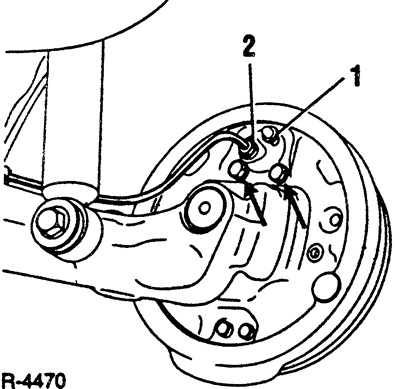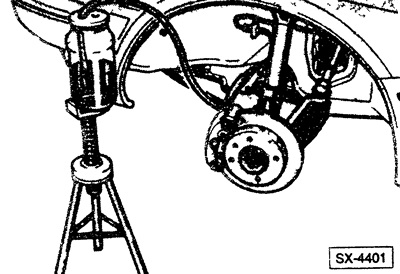Air is removed from the brake system by bleeding the brake pedal, which requires an assistant.
If it is necessary to bleed the entire system, the air is bled from each wheel brake separately. This happens when air enters each individual brake cylinder.
Air removal sequence:
- 1. Rear left brake cylinder.
- 2. Front right brake cylinder.
- 3. Rear right brake caliper (or cylinder).
- 4. Front left brake caliper.
If only one caliper or working brake cylinder has been replaced or repaired, it is usually sufficient to bleed the respective brake cylinder.
Before bleeding, unscrew the reservoir cap and add brake fluid to the MAX mark.
Caution: When bleeding air, occasionally look at the brake fluid reservoir. The liquid level must not drop too much, otherwise air will be sucked through the tank. Top up with new brake fluid!

Remove cap -1- from the brake cylinder bleeder valve and insert a wrench. Clean the valve, connect a clean transparent hose, lower the other end of the hose into a bottle half filled with brake fluid (suitable hose and appropriate container available from spare parts stores). On an old vehicle, spray the air outlet valve with a rust remover spray and carefully make the valve turn freely.
The brake fluid container must be placed at least 30 cm above the bleeder valve, otherwise air will enter the system through the valve threads.
Have an assistant depress the brake pedal several times until the brake system is pressurized. This will be felt by the increased resistance when you press the pedal.

When the pressure is reached, keep the pedal depressed.
Open the brake caliper bleed valve about half a turn with a wrench. The brake fluid will drain into the vessel. Make sure that the end of the hose in the vessel is constantly inside the liquid.
As soon as the fluid pressure drops, immediately close the air release valve.
Repeat the inflation process until pressure builds up. Keep your foot on the pedal. Open the air release valve until the pressure drops. Close valve.
Continue the process of removing air from the brake cylinder until no more air bubbles are released from the liquid flowing into the bottle.
After venting, carefully tighten the valve to approx. 10 Nm.
Remove the hose, put the cap on the valve.
In the same way, remove air from the cylinders of the remaining wheels, following the above sequence of actions.
After removing the air, the tank should be filled up to the MAX mark and close the tank with a lid.
